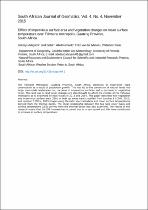 ResearchSpace
ResearchSpace
Effect of impervious surface area and vegetation changes on mean surface temperature over Tshwane metropolis, Gauteng Province, South Africa
JavaScript is disabled for your browser. Some features of this site may not work without it.
- ResearchSpace
- →
- Research Publications/Outputs
- →
- Journal Articles
- →
- View Item
| dc.contributor.author |
Adeyemi, A

|
|
| dc.contributor.author |
Botai, J

|
|
| dc.contributor.author |
Ramoelo, Abel

|
|
| dc.contributor.author |
van der Merwe, F

|
|
| dc.contributor.author |
Tsela, P

|
|
| dc.date.accessioned | 2016-05-16T07:57:23Z | |
| dc.date.available | 2016-05-16T07:57:23Z | |
| dc.date.issued | 2015-11 | |
| dc.identifier.citation | Adeyemi A, Botai J, Ramoelo A, van der Merwe F, Tsela P. 2015. Effect of impervious surface area and vegetation changes on mean surface temperature over Tshwane metropolis, Gauteng Province, South Africa. In: South African Journal of Geomatics, 4(4), pp 1-18 | en_US |
| dc.identifier.issn | 2225-8531 | |
| dc.identifier.uri | http://www.sajg.org.za/index.php/sajg/article/view/232 | |
| dc.identifier.uri | http://hdl.handle.net/10204/8521 | |
| dc.description | Copyright: 2015 CONSAS conference. Due to copyright restrictions, the attached PDF file only contains the abstract of the full text item. For access to the full text item, please consult the publisher's website. The definitive version of the work is published in South African Journal of Geomatics, 4(4), pp 1-18 | en_US |
| dc.description.abstract | The Tshwane Metropolis, Gauteng Province, South Africa, continues to experience rapid urbanization as a result of population growth. This has led to the conversion of natural lands into large man-made landscapes i.e., increase in impervious surfaces and a decrease in vegetative cover. This land use or land cover changes are also thought to affect the climate of the Tshwane metropolis as is evidenced by heat waves in 2013 and 2014. This paper describes how vegetation and impervious surface area (ISA) or built up areas were classified from Landsat 8 LCDM, 2013, and Landsat 7 ETM+, 2003 images using thematic spectral indices and mean surface temperatures derived from the thermal bands. The linear relationship between the two land cover types and surface temperature (LST) derived from the thermal bands was also examined. The results of this research reveal that the ISA increase has occurred due to urban sprawl and this have contributed to increase in surface temperature. | en_US |
| dc.language.iso | en | en_US |
| dc.publisher | CONSAS conference | en_US |
| dc.relation.ispartofseries | Workflow;15898 | |
| dc.subject | Thematic indices | en_US |
| dc.subject | Surface temperature | en_US |
| dc.subject | Landsat | en_US |
| dc.subject | Vegetation | en_US |
| dc.subject | Impervious Surface Area | en_US |
| dc.subject | ISA | en_US |
| dc.subject | Tshwane Metropolis | en_US |
| dc.title | Effect of impervious surface area and vegetation changes on mean surface temperature over Tshwane metropolis, Gauteng Province, South Africa | en_US |
| dc.type | Article | en_US |
| dc.identifier.apacitation | Adeyemi, A., Botai, J., Ramoelo, A., van der Merwe, F., & Tsela, P. (2015). Effect of impervious surface area and vegetation changes on mean surface temperature over Tshwane metropolis, Gauteng Province, South Africa. http://hdl.handle.net/10204/8521 | en_ZA |
| dc.identifier.chicagocitation | Adeyemi, A, J Botai, Abel Ramoelo, F van der Merwe, and P Tsela "Effect of impervious surface area and vegetation changes on mean surface temperature over Tshwane metropolis, Gauteng Province, South Africa." (2015) http://hdl.handle.net/10204/8521 | en_ZA |
| dc.identifier.vancouvercitation | Adeyemi A, Botai J, Ramoelo A, van der Merwe F, Tsela P. Effect of impervious surface area and vegetation changes on mean surface temperature over Tshwane metropolis, Gauteng Province, South Africa. 2015; http://hdl.handle.net/10204/8521. | en_ZA |
| dc.identifier.ris | TY - Article AU - Adeyemi, A AU - Botai, J AU - Ramoelo, Abel AU - van der Merwe, F AU - Tsela, P AB - The Tshwane Metropolis, Gauteng Province, South Africa, continues to experience rapid urbanization as a result of population growth. This has led to the conversion of natural lands into large man-made landscapes i.e., increase in impervious surfaces and a decrease in vegetative cover. This land use or land cover changes are also thought to affect the climate of the Tshwane metropolis as is evidenced by heat waves in 2013 and 2014. This paper describes how vegetation and impervious surface area (ISA) or built up areas were classified from Landsat 8 LCDM, 2013, and Landsat 7 ETM+, 2003 images using thematic spectral indices and mean surface temperatures derived from the thermal bands. The linear relationship between the two land cover types and surface temperature (LST) derived from the thermal bands was also examined. The results of this research reveal that the ISA increase has occurred due to urban sprawl and this have contributed to increase in surface temperature. DA - 2015-11 DB - ResearchSpace DP - CSIR KW - Thematic indices KW - Surface temperature KW - Landsat KW - Vegetation KW - Impervious Surface Area KW - ISA KW - Tshwane Metropolis LK - https://researchspace.csir.co.za PY - 2015 SM - 2225-8531 T1 - Effect of impervious surface area and vegetation changes on mean surface temperature over Tshwane metropolis, Gauteng Province, South Africa TI - Effect of impervious surface area and vegetation changes on mean surface temperature over Tshwane metropolis, Gauteng Province, South Africa UR - http://hdl.handle.net/10204/8521 ER - | en_ZA |





